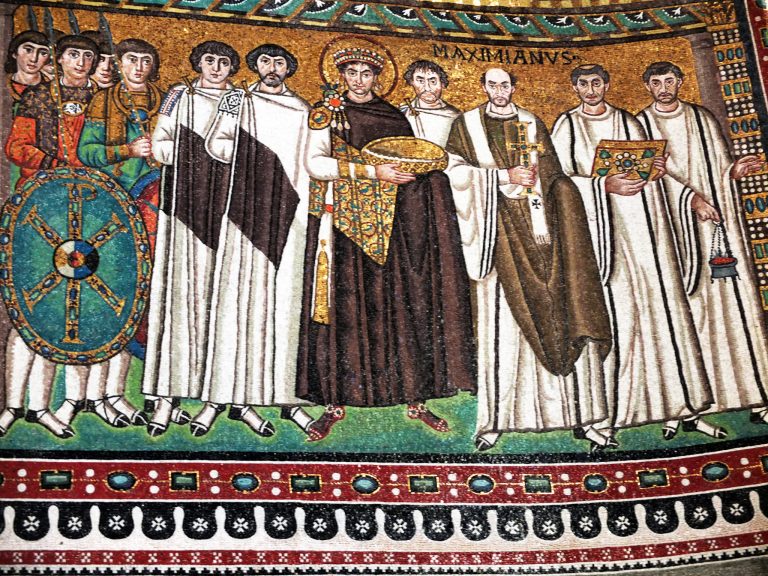
In 49BC, Julius Caesar assembled his troops in Ravenna for his famous march across the Rubicon River, an action that started a civil war and basically ended the Roman Republic.
Caesar came in from France where he had just defeated Vercingetorix and the army of the Gaul at the Battle of Alesia in what is now the Languedoc of France. Caesar was ordered to return to Rome to face charges of war crimes (amongst other trumped up charges by jealous Republican Senators). Instead, he decided to take the matter into his own hands and change history. Yes, it would have been much faster to march from southern France, past Marseilles and Nice and down via Aurelia along the coast of the Mediterranean Sea. But all of the Roman cities along the way were loyal to the Republic. Caesar needed to take the long way around to the Adriatic coast in order to build up his army.
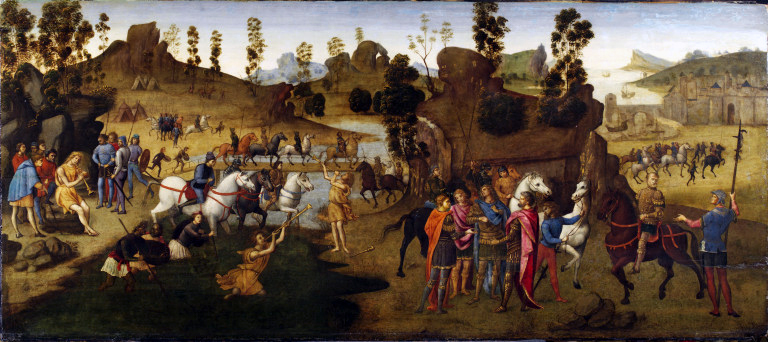
Even though the Rubicon River doesn’t exist any longer, the name has etched itself forever into history. Dams built to control the floods in the coastal plains of the Adriatic took it away in the Middle Ages. It is now buried under the ugly industrial town on Savignano sul Rubicon, about 15km northwest of Rimini.
By the end of the 5th century, Rome became more or less a city unable to defend itself against. The empire got too big and just cracked.
After the death of Theodosius the Great in Constantinople in 395 his son Arcadius was promoted to Emperor of the East. His younger brother Honorius was declared Emperor of the West. Sounded like a good idea but it didn’t turn out so good. Both of the sons were too young to govern properly and before he died, Theodosius asked the Roman General Flavius Stilicho to look after him till he got wise enough. Stilicho was probably the last of the great western generals (consort) of Rome. He kept the Ostrogoths at a good distance through wars and truce agreements but by 405, the idiots in the Roman Senate decided Stilicho had too much power and he was removed, banished to Ravenna and executed for trumped up charges in 408. One more of the grand mistakes made by the “so called” elected officials.
Honorius was too young to govern, Pope Innocent I was too inexperienced in dealing with the demands of the Ostrogoths and in 410 Alaric and his Ostrogoths army attacked the walls of Rome. After months of siege, starvation (the citizens resorted to cannibalism), someone finally had enough and opened one of the gates letting in the invaders on August 410.
The young Emperor Honorius was in Ravenna during the siege. According to Procopius, when one of the royal eunuchs informed Honorius that Roma had perished, the young emperor fell to tears thinking it was his pet chicken “Roma” who had died and not his glorious city.
Theodosius the Great was the last Roman Emperor to rule both the eastern and western parts of the empire. When he died in 395 the empires were split. The Goths had pretty much taken control of the west although they still let the Roman Emperors rule till 476. As long as the Romans continued to be a supply of money and food for the Goths it was a good relationship.
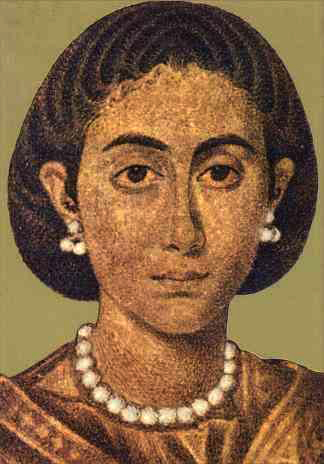 In 408, after Stilicho was banished to Ravenna, Aelia Galla Placidia, the daughter of Theodosius the Great and brother of the Emperor Honorius was also sent there for her protection, but protection didn’t last very long. Galla Placidia was captured by Alaric, King of the Visigoths and ended up as the consort or wife of his successor, Ataulf. They were married in Narbonne, France. When Ataulf was killed off, she was married off to the Western Roman emperor Constantius III, who became the co-emperor with her brother Honorius. Together, Constantius III and Galla Placidia had two children and although her son Valentinian III was next in line on the throne, when both Constantius III and her brother Honorius died of mysterious diseases (one of the major causes of death at this time was “mysterious disease”), Galla Placidia became Royal Regent from 423 till 438. She ruled the Western Empire for 15 years before her son Valentinian III reached the age of 18.
In 408, after Stilicho was banished to Ravenna, Aelia Galla Placidia, the daughter of Theodosius the Great and brother of the Emperor Honorius was also sent there for her protection, but protection didn’t last very long. Galla Placidia was captured by Alaric, King of the Visigoths and ended up as the consort or wife of his successor, Ataulf. They were married in Narbonne, France. When Ataulf was killed off, she was married off to the Western Roman emperor Constantius III, who became the co-emperor with her brother Honorius. Together, Constantius III and Galla Placidia had two children and although her son Valentinian III was next in line on the throne, when both Constantius III and her brother Honorius died of mysterious diseases (one of the major causes of death at this time was “mysterious disease”), Galla Placidia became Royal Regent from 423 till 438. She ruled the Western Empire for 15 years before her son Valentinian III reached the age of 18.
I know I’m straying a bit from the story of Ravenna, but I just can’t help myself.
As I mentioned, Galla Placidia had two children. Although Valentinian III was the rightful heir, her daughter Justa Grata Honoria felt that she was more entitled. Honoria first plotted to overthrow her brother by forming an alliance with the overseer of her estates. When he was killed off, Honaria was sent to Constantinople where she was under house arrest. It was here in 1450 when she wrote a love letter to Atilla to help her. Atilla interpreted the letter as a proposal of marriage to which he replied he would agree only if half of the Roman Empire was given to him. Honoria refused and Attila invaded Rome in 451-452. He wanted the empire more than the wife.
Valentinian III turned out to be one of the worst Emperors in the history of Rome. In a very short time he lost Africa, Spain and Gaul and ended up giving most of the administrative power to Pope Leo I who had to mop up the mess with Atilla.
Valentinian III was eventually murdered by his bodyguards in 455. No one really knows what happened to Honoria. She probably died from a mysterious disease.
After Valentinian III, the Roman rulers of the western empire for the next 20 years were more or less puppets under the Goth generals. The puppet charade finally ended on September 4th, 476 when a German Soldier named Flavius Odoacer decided to just take Ravenna and boot out the 16 year old Romulus Augustulus.
Odoacer became the first King of Italy after the Fall of the Western Roman Empire, something that wouldn’t happen again until 1861 with King Vittorio Emanuele II and the Italian Unification.
No one really knows what happened to Romulus Augustulus. There stories range from him killed by Odoacer to being transported to Britain where he became King Arthur. Or, he could have died from a mysterious disease.
Odoacer, however, was killed (personally) by Theodoric the Great, the King of the Ostrogoths who ruled as King of Italy from Ravenna until 501.
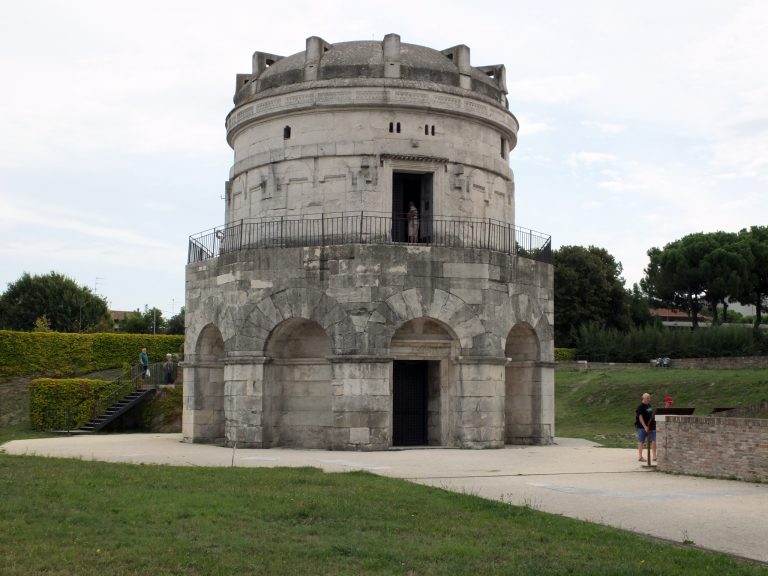
Theodoric died in Ravenna in 526 and was buried in his 52’ high Mausoleum that still stands today. It’s a masterpiece of 6th century engineering. The original floor of the current mausoleum actually sits about 12 feet below ground level. Ravenna sits on top of a flood plain filled with underground rivers. The problem of sinking architectural treasures has become a main concern of all the great monuments of the city.
The dome of Theodoric’s Mausoleum was made of one piece of marble weighing 230 metric tons, an amazing feat of construction. There is a very visible crack on one side of the dome that goes back to an ancient prophecy. Theodosius was told he would be struck down from a lighting bolt and so he made sure the dome was a secure protections and he used the mausoleum as a temple of refuge from any storm. Many (or I should say most people of the area and the story) believe the lighting struck while Theodosius was inside. Others believe that it cracked when it was installed.
The Mausoleum was converted into a church when Belisarius re-conquered the city in an attempt to reunify the empire in 540. Belisarius and the Emperor Justinian actually did reunite the ancient empire but only until the reign of his nephew Justin II, who wasn’t very fond of paying the barbarians to keep the peace.
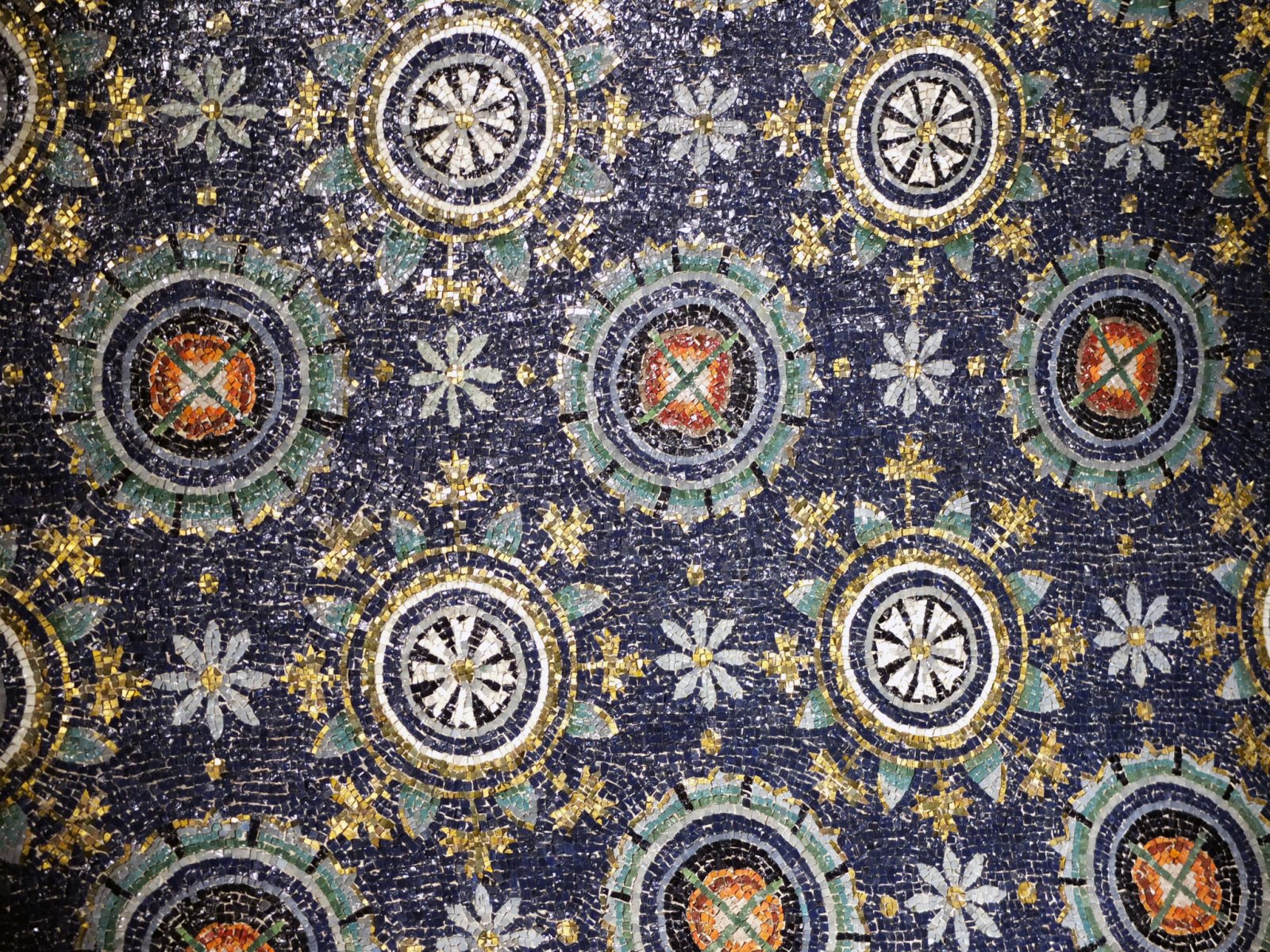 Galla Placidia remained the Empress Mother until her death in 450. She lived most of these years in Ravenna and was responsible for much of what we can still see here. She eventually moved back to Rome where she died. She was buried in Rome. The great building known as the Mausoleum of Galla Placidia is not a mausoleum nor was it ever intended to be a mausoleum, although someone did move a grand sarcophagus into the chapel in the 9th century that is still there today. The mausoleum story was created by Renaldo Da Concordezzo , the Archbishop of Ravenna in the 14th century. He was a friend of Dante, a champion of the Knights of Templar and a great story teller. The 5th century chapel (alias Mausoleum) of Galla Placidia is a beautiful place with mosaic stars overhead, animal scenes on the side walls and the tribute to St Lawrence where the chapel alter once stood (now replaced by the large 9th century sarcophagus).
Galla Placidia remained the Empress Mother until her death in 450. She lived most of these years in Ravenna and was responsible for much of what we can still see here. She eventually moved back to Rome where she died. She was buried in Rome. The great building known as the Mausoleum of Galla Placidia is not a mausoleum nor was it ever intended to be a mausoleum, although someone did move a grand sarcophagus into the chapel in the 9th century that is still there today. The mausoleum story was created by Renaldo Da Concordezzo , the Archbishop of Ravenna in the 14th century. He was a friend of Dante, a champion of the Knights of Templar and a great story teller. The 5th century chapel (alias Mausoleum) of Galla Placidia is a beautiful place with mosaic stars overhead, animal scenes on the side walls and the tribute to St Lawrence where the chapel alter once stood (now replaced by the large 9th century sarcophagus).
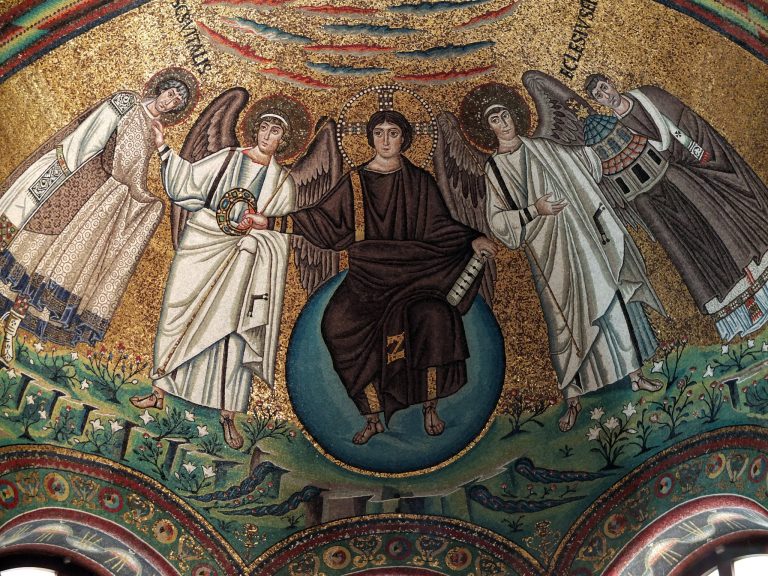
Very close to Galla Placidia’s Chapel (Mausoleum) is the beautiful 6th century Basilica of San Vitale, possible the best example of Byzantine mosaic art in the world. There are scenes of the old and new testaments. Above the alter is the very famous mosaic of a clean shaven Jesus as a Shepherd. On the sides of the alters are the images of the Emperor Justinian with his Generals Belisarius to his left and Narses to his right (image at top of page). You’ll notice that Justinian is stepping on the foot of Belisarius just to show the world that even though Belisarius was the greatest General of the 6th century Empire, he was still subordinate to the Justinian. This rivalry and competition lasted throughout their lives. They died within months of each other.
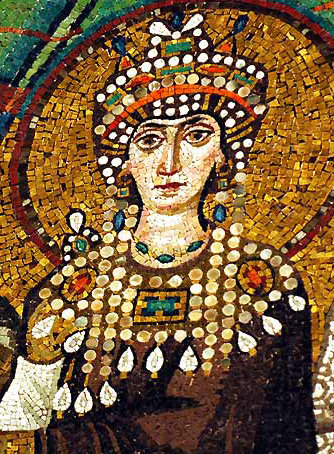
Across the aisle is the mosaic of the Empress Queen (ex stage dancer and prostitute) Theodora in her splendorous robes and jewels. She is attended to by a line of handmaidens. Her face is white and gaunt. Some say this is a sign beauty in the 6th century. However another belief is that it was a portrait of Theodora months before she died of cancer. She was very sick at the time the mosaic was created.
Justinian, son the Emperor Justin I was fond of visiting the houses of prostitution during his youth and when he met Theodora he fell in complete love with her. They were married and she became his Empress. The scandal haunted them throughout their lives, resulting at it’s worst in the Nikka Revolt that almost destroyed the city of Constantinople, but he was the Emperor and the Emperor prevails.
On the underside arch in front of the altar holding these magnificent mosaics the portraits of the 14 apostles. Yes, I know there are only 12 of them today but apparently in the 6th century there were 14. Proteas and Gerveas were removed for some reason. Our excellent historical guide, Anna Missiroli, told us another explanation that there were 14 artists who worked on the mosaics this was their way of signing their names. Each one created one of the apostles.
At the height of Ravenna in the 6th and 7th centuries the city had a population of around 100,000. The population today is about 98,000.
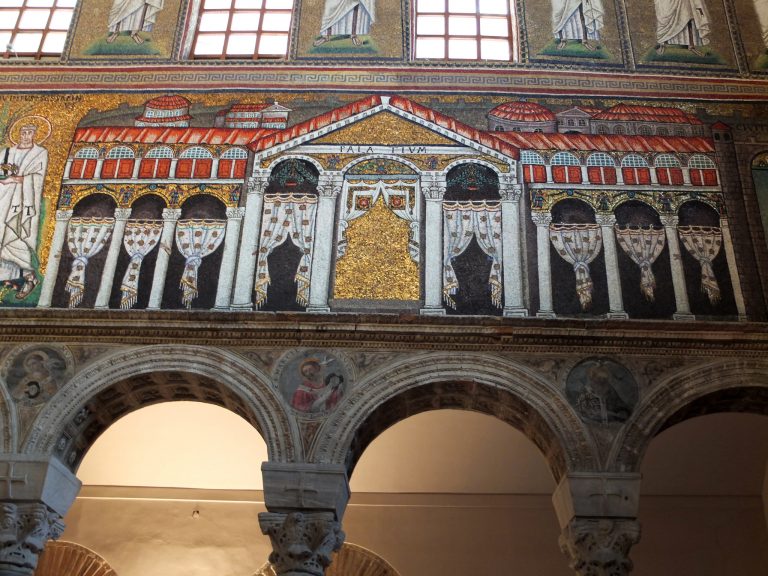
Theodoric built the Basilica of Sant’Apollinare Nuovo in 504 but after his death many of the mosaics were changed.
Theodoric was an Arian Christian who believed in the doctrine the Jesus Christ was a man and not a god. According to Arian Doctrine. Christ did rise to heaven to sit with God but there was no trinity of Father, Son, Holy Ghost. Anna explained to us that the concept of Trinity was very difficult for the people to understand. They needed a Priest to explain it to them and even then they were confused. Arianism took all the confusion away. There was a god, a man who was brought to heaven by the god and a holy spirit of god that was given to mankind. It was all too simple and took away too many layers. The powers of Orthodox church felt threatened.
For a while, from the time of Theodosius the Great and Galla Placidia in the late 5th century to the mid 6th century Arian and Orthodox Christians lived together side by side. Theodoric willed the Kingdom to his grandson, Athalaric, but his Gothic education was more in drinking and debauchery and the poor lad died at age 18 in 534.
In 535, in came Emperor Justinian and his General Belisarius and out went all traces of Arianism.
And even though Theodoric was from a Germanic tribe, the Arian Cult has absolutely nothing in common with the Aryans of 19th and 20th century Germany. Aryan comes from a Sanskrit word arya, which means respectable and noble. Now it means something destructive, brutal and really sad.
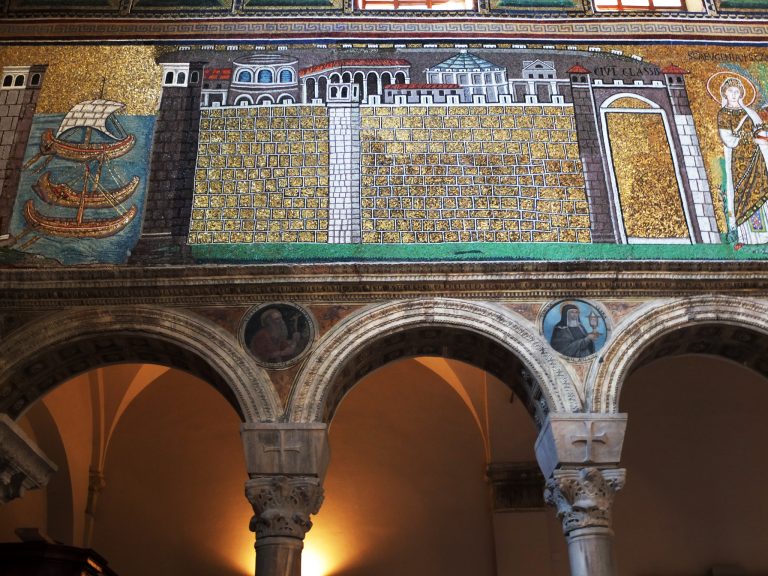 What I love the most about the Basilica of Sant’Apollinare Nuovo is as you enter, look up to the right and left. Over the wall to the right (looking towards the altar) is a mosaic illustration of the Palace of Theodoric. It might have been the same Palace where the Emperors of Rome ruled in the 4th century. Over the left wall (still facing the altar) is an ancient mosaic illustration of the city of Classe on the harbor. These are the only two references of these places.
What I love the most about the Basilica of Sant’Apollinare Nuovo is as you enter, look up to the right and left. Over the wall to the right (looking towards the altar) is a mosaic illustration of the Palace of Theodoric. It might have been the same Palace where the Emperors of Rome ruled in the 4th century. Over the left wall (still facing the altar) is an ancient mosaic illustration of the city of Classe on the harbor. These are the only two references of these places.
During the period of the 5th through 7th centuries there were hundreds of beautiful buildings in this city. Today, only 8 of them remain.
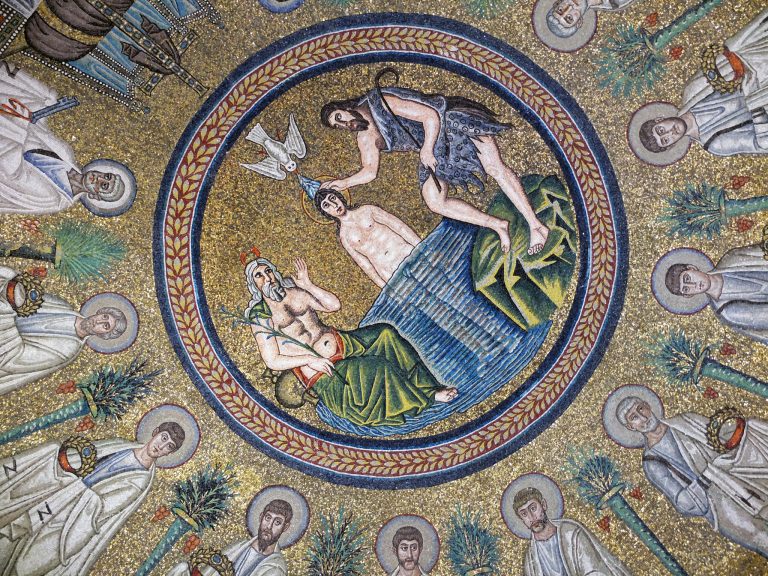
Two of them are baptisteries. The Arian Baptistery is near Theodoric’s church of Sant’Apollinare Nuovo. The octagonal shape and the ceiling mosaic of a John the Baptist dressed in a leopard skin immersing a beardless and naked Jesus into the river are all original. The rest of the walls are bare. It is simple, peaceful and a free entry.

However, if you only have time for one of the baptisteries, pay the admission cost and visit the Neonian (or orthodox) Baptistery near the Archiepiscopal Museum (a meeting of Byzantine parts and pieces). The baptismal font in the Neonian is 15th century or later. The original font was cut into the floor so the baptized would have the experience of being baptized in the river Jordan. They would lie down in the water and look up at the images of Jesus and the stars and all the other amazing mosaic illustrations. As with all the 5th century buildings of Ravenna, the floor of this one has also been raised, probably close to 12 feet. The original baptismal font is no longer visible.
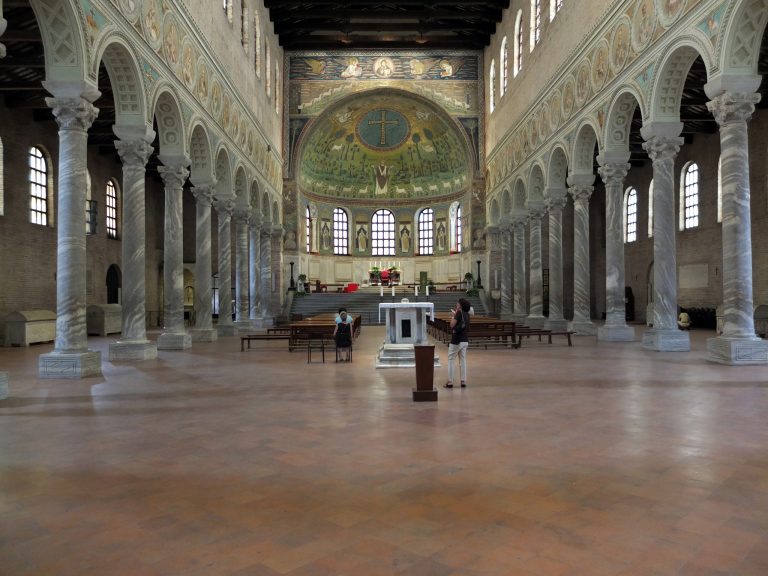
A short 8km out of town is the 6th century Basilica Sant’Apollinaris in Classe, built between 532-536 when the Basilica sat at the harbor of Classe, the once great Harbor of Romans where troops sailed in to join the Armies of Julius Caesar in his civil war against the Roman Republic. The only known image of the harbor is the mosaic in the Basilica di Sant’Appolinare Nuovo. The harbor is long gone now. It dried up centuries ago. Saint Appollinaris is the patron saint of Ravenna and Classe. According to legend, he was made Bishop of Ravenna by Saint Peter of Rome.
The mosaics in the grand Basilica of some of the best in the city and well worth the trip from the old city out to Classe. Some of the mosaics were added by Constantinople Emperor Constantine IV in the 7th century.
Most of the marble that once covered the walls of the Basilica was removed in the 15th century by Sigismondo Pandolfo Malatesta (see my 2013 post on Rimini) who brought it back to Rimini to built his church the Tempio Malatesta.
Our final stop of a really great day was to the Basilica of San Francesco, mostly built in the 10th and 11th centuries. This was the favorite church of the Da Polenta family, the most powerful family of the area through the 16th century. In the story of Francesca and Paolo that I wrote about in 2013 – Rimini, Francesca was the daughter of the Da Polenta family who was betrothed to Giovanni Malatesta of Rimini in a political alliance. Francesca fell in love with Giovanni’s brother Paolo and they both ended up in the 2nd circle of Dante’s Divine Comedy.
Dante, who was run out of Florence in 1301 for his ideological differences with the Pope and the French government installed in Florence, eventually ended up in Ravenna at the invitation of the Da Polenta Family. The funeral for Dante Alighieri was held in the Basilica of San Francesco in 1321. Dante’s tomb is behind the basilica.
Ravenna of the 6th century was a city of 100,000 people. In 2013 it’s a city of around 98,000 people. In the 15th century the canals and architecture resembled a small Venice. The Venetians had control of the city from 1441 till 1509 when they handed it over to Pope Julius II.
Flood control over the years closed up all the canals and filled them in with beautiful stone streets perfect for an afternoon stroll or bicycle ride.
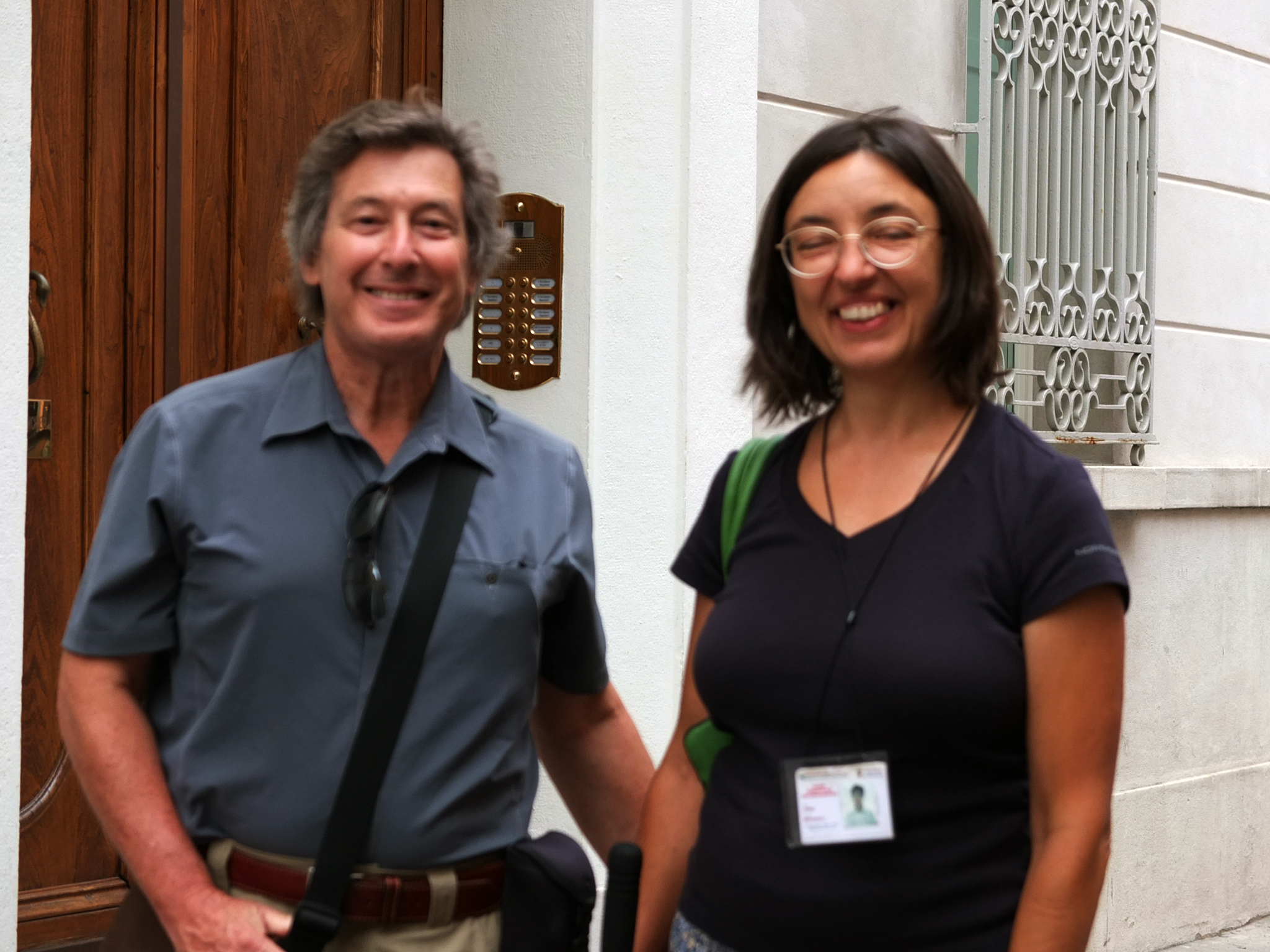 If you want a great guide for Ravenna or any of the towns and cities near the Po River we highly recommend Anna Missiroli at anna.missiroli@tiscali.it. Anna is an architectural and art historian and a really great person. We had a excellent day with her. Thank you Anna.
If you want a great guide for Ravenna or any of the towns and cities near the Po River we highly recommend Anna Missiroli at anna.missiroli@tiscali.it. Anna is an architectural and art historian and a really great person. We had a excellent day with her. Thank you Anna.
For more photos of Ravenna, click here.
You must be logged in to post a comment.